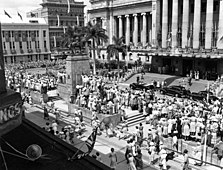King George Square



King George Square is a public square located between Adelaide Street and Ann Street (and between two sections of Albert Street) in Brisbane, Queensland, Australia. Brisbane City Hall is adjacent to the square.
On 1 January 2004, King George Square was listed on the Brisbane Heritage Register.[1]
History
[edit]Albert Square
[edit]Originally, Albert Street ran west from the Botanic Gardens as far as Ann Street and the original city markets. Market Square was located between Ann Street and Adelaide street, south of Albert Street. This became the site of the Brisbane City Hall, which was completed in 1930. The City Hall was set back from Albert Street and this widened area of Albert Street, and some land north of the street, was renamed Albert Square in honour of Prince Albert, husband of Queen Victoria. The National Library of Australia holds photographs of Albert Square, which pre-date King George Square in its present form.[2][3] When Albert Square was redeveloped into King George Square, the fountain at Albert Square was relocated to Wynnum.
In 1912, then Albert Square was the site of the 1912 Brisbane general strike. Over 15,000 trade unionists held a march in Market Square after being refused a permit to protest, on the orders of Commissioner Cahill, the police charged and attacked peaceful protesters, in what became known as 'Black Friday'.
King George Square
[edit]Following the death of King George V in 1936, the square was widened to include the area which had been Albert Street, and renamed King George Square in honour of the King. The bronze Lion sculptures, which appear to guard the King George Square entrance to the Brisbane City Hall, were initially on large sandstone plinths, as part of the George V memorial, which was unveiled in 1938, as a tribute to the King from the citizens of Brisbane.
Vehicular traffic, including a trolley-bus route, operated through the square until 1969, when the roadway was closed to traffic. Buildings on the northern side of the square were acquired by the City Council including the Tivoli Theatre[4] and the Hibernian Building and demolished[5] and work commenced on the construction of the underground King George Square Car Park. At the time of the construction, the statues, including that of King George V and the brass lions, were relocated to their present positions in the square and, between the statues and King George Square, there is now a narrow laneway (replacing the former roadway) for the infrequent passage of Government vehicles (or work vehicles) to be driven to the front of the City Hall.
A round-shaped fountain, located in the centre of King George Square, was also demolished, and a rectangular-shaped fountain built. As a direct result of the 2005–07 drought, the water in the rectangular-shaped fountain was temporarily replaced by a special "Watersense garden" with drought-resistant plants.
There are statues of some famous Queenslanders in a special section of King George Square, which is called "Speakers' Corner". The statues are of Steele Rudd (1868–1935), Emma Miller (1839–1917), and Sir Charles Lilley (1830–1897). Bronze sculptures from the Expo '88 site have also been incorporated into the square's design.
2009 redevelopment
[edit]In October 2009 the new King George Square was opened after 16 months redevelopment. The square's design is by UbrisJHD[6] selected in a national design competition.[7] The square redevelopment followed the conversion of the underground lower two levels of the King George Square Car Park into the King George Square busway station.
The redesign has been heavily criticised for excess surface heat, glare and its lack of grass and shade.[8][9]
-
Anzac Day procession through Albert Square, 1937
-
Eleanor Roosevelt in King George Square during World War II, 1943
-
Elizabeth II during her 1954 royal tour
-
Pope John Paul II addressing the public, 1986
-
Sack Scomo rally, 2019
References
[edit]- ^ "King George Square". Brisbane Heritage Register. Brisbane City Council. Retrieved 31 July 2021.
- ^ "Albert Street, showing the King George V monument and fountain before the City Hall, mountains beyond". nla.gov.au. Archived from the original on 3 March 2016. Retrieved 15 April 2018.
- ^ "King George V Square and Town Hall, Brisbane". nla.gov.au. Archived from the original on 3 March 2016. Retrieved 15 April 2018.
- ^ "Tivoli Theatre and Roof Garden in Brisbane, AU - Cinema Treasures". cinematreasures.org. Retrieved 7 January 2020.
- ^ East, John W. (2019). "Urban Improvement in Brisbane between the Wars An Architectural History of the Widening of Adelaide Street 1924 to 1931". espace.library.uq.edu.au. Retrieved 7 January 2020.
- ^ Bruce McMahon (22 October 2009). "King George Square revamp sparks mixed reaction". www.couriermail.com.au. Archived from the original on 24 October 2009. Retrieved 13 November 2009.
- ^ "King George Square revamp sparks mixed reaction". Retrieved 14 May 2015.[permanent dead link]
- ^ Marissa Calligeros (26 October 2012). King George Square too hot to handle Archived 10 October 2012 at the Wayback Machine. Brisbane Times. Fairfax Media. Retrieved on 17 December 2012.
- ^ "King George Square designer wouldn't change a thing despite calls to bring back the grass". www.couriermail.com.au. Retrieved 14 May 2015.
External links
[edit]- Brisbane City Council e-Library Catalogue (elibcat)image BCC-T120-94615 Archived 27 September 2007 at the Wayback Machine 1994 aerial view of Brisbane City Hall and King George Square looking south along Albert Street. The photo also shows the round fountain in King George Square which was later demolished.
- 2700 Second Challenge workshop
- Google map






